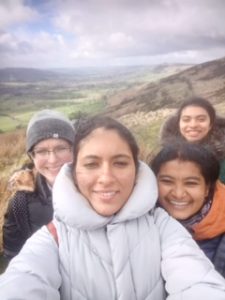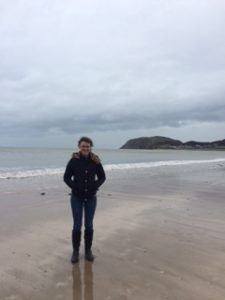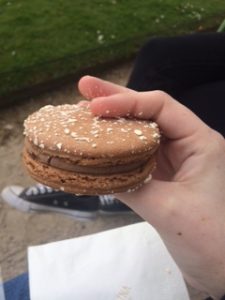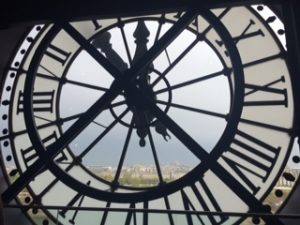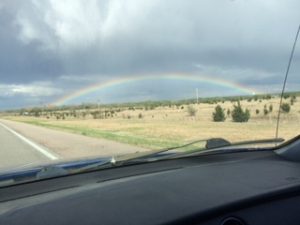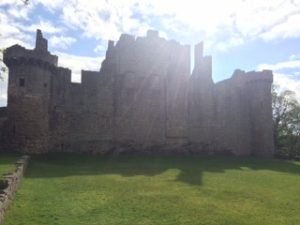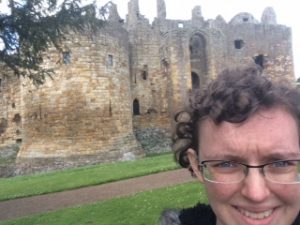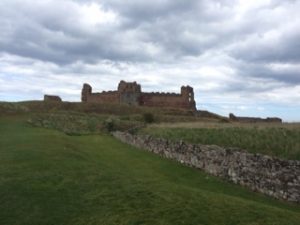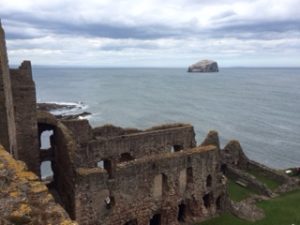Being a Global Engagement Fellow has been a great experience. I probably wouldn’t have been involved in French Club if it hadn’t been a requirement, but I am very glad that I was involved because I genuinely love learning and speaking French. I have always been quite introverted, so I tend to avoid social interaction whenever possible, but being a GEF has forced me to overcome that. Most of all, spending a year in England helped me to learn how to be confident and independent. I am so glad that I had that opportunity. I also never would have considered applying for nationally competitive scholarships if I hadn’t spent a year in England building up my confidence, and receiving the Fulbright was just icing on the cake. I never dreamed that I could have a competitive Fulbright application, but being a GEF made it possible.
Steel Pan Festival
This semester, I joined the steel pan ensemble, and OU hosted a steel pan festival early in the semester. Although the festival itself wasn’t particularly international (mostly just a bunch of students from Oklahoma high schools attended), we got to attend a master class that talked about how important the steel pan is in Trinidad and Tobago culture. The steel pan originated in the late 1800s. African percussive instruments were banned in 1880, so people began beating on pots, pans, and oil drums instead. This new music eventually evolved to where people were tuning various parts of the oil drums to have different pitches. These tuned oil drums became immensely popular, and they are now a huge part of the culture. Each year they hold huge music festivals and competitions, where each ensemble often has hundreds of players. Music ranges from traditional local music to jazz music to classical orchestral music, and performances always include lots of choreography and dancing.
Chickasaw Nation – Visual Arts
I wrote this paper for NAS 1013 (Intro to Native American Studies). The prompt was to discuss some aspect of modern Native American life based on what we find in a given tribe’s newspaper archives.
“The study of arts and humanities highlights culture by expressing the beauty, strength, intelligence and spirit of the people and enhances the rich legacy of who Chickasaws were, who they are and who they will be.”*
The visual arts are evidently a significant aspect of Chickasaw culture. Of all the newspaper editions from January 2019 through April 2020, every single one featured at least one article about some form of visual art, often on the front page. Topics ranged from festivals and showcases to classes and competitions, from painting and sculpture to fashion design and filmography. Art is a means to express cultural identity and to preserve cultural heritage. Through this art, one can understand how the Chickasaw Nation views its past, present, and future.
Although art programs have been cut from many schools, the Chickasaw community is still committed to supporting art education. The Chickasaw Arts Academy is a two-week summer program for students between 8 and 18 years of age, and it features training in both the visual and performing arts with curriculum that is deeply rooted in Chickasaw culture. Younger students receive instruction in a broad range of subjects, while older students choose specific subjects on which they wish to focus. The experience culminates in a showcase and arts gala where students can display or perform their work. With art programs being cut from many schools, this program is often the only source of art education available to students, although some communities have access to after-school art programs at local galleries. The resounding success of the Academy demonstrates how greatly the community values artistic talent being passed on to the next generation. For adults, there are beadwork classes, moccasin making classes, and classes for numerous other traditional artforms that are regularly held at various locations across the Chickasaw Nation. These are valuable opportunities for tradition to be shared so that historical artistic methods are not lost.
Due to the great importance of art in the community, the Chickasaw Nation holds many art festivals and conferences throughout the year. Perhaps the most popular is the Artesian Arts Festival, held each May. This intertribal event features a variety of art, both traditional and modern, and includes competitions for a wide range of artistic media. In 2019, more than 11,000 people attended. In addition, the Native Creativity Fashion Show, the Holba’ Pisachi’ Native Film Festival, and the Imanoli Creative Writers Conference were all hosted by the Chickasaw Nation in 2019. The goal of each of these events was to share expressions of Native American culture that are both sensitive to history and relevant in modern times. The Native Creativity Fashion Show showcased a variety of modern designs that were inspired by each designer’s cultural heritage; design techniques are often deeply rooted in tradition and memories, yet they are applied to modern ideas and styles to create a unique marriage of old and new. This is a common theme in much of Native American art, as there is often a great desire to preserve the incredible craftsman techniques of old while still developing cutting-edge art that can be appreciated by a modern audience. In the film industry, this theme is expressed differently. The Holba’ Pisachi’ Native Film Festival featured the screening of nearly twenty Native American films, each with the same goal of telling the correct version of Native American stories. From its inception, the film industry has been dominated by non-Native perspectives, so the Chickasaw Nation developed its own film industry to give Natives an opportunity to tell their own story. Just as with other forms of art, these films aim to preserve ancestral perspectives and values while maintaining relevance in the modern day.
Further evidence of the importance of art in Chickasaw culture can be found in two galleries located on the reservation. The Chokma’si Gallery displays and sells art from the Chickasaw Nation and other Southeastern Native tribes. The purpose of the gallery is to benefit the community by providing evidence of the evolving and thriving Chickasaw culture. The ARTesian Gallery and Studios contains rotating exhibits of local artist work and several art studios where in-house artists and other locals can work. The in-house artists often do demonstrations for visitors and teach classes throughout the year. The main goal of these galleries is to get the local community involved in art, either through art appreciation or actual involvement in art creation. But the exhibit that Chickasaw artists are most proud of is the Visual Voices: Contemporary Chickasaw Art touring exhibition, which features 57 artworks by 15 Chickasaw artists. The exhibit premiered in June 2018 at the Fred Jones Jr. Museum of Art at the University of Oklahoma. It has also been displayed in museums in Mississippi, New Mexico, and North Carolina. The traveling exhibit provides a valuable opportunity for people outside the Native American community to appreciate the talents of Chickasaw artists.
Chickasaw artists of all ages are widely recognized for their artistic talent. Kaylee Martin won Best of Show in the youth division at the Red Earth Festival in 2019 for her metalwork sculpture of a buffalo, and this is the third time in four years that a Chickasaw student has won the top honor. Also in 2019, Mary Ruth Barnes received a national honor from the National Society of the Daughters of the Revolution for her life of artistic creativity and her commitment to serving others with her talents, and Daniel Worcester received a Medal of Honor for Community Service during the Governor’s Arts Awards. Worcester is well-known in the Native American arts community, as he has received numerous awards for his bladesmith skills, including countless first place ribbons at the Red Earth Festival and being named the Red Earth Honored One in 2013 for his support and influence of younger Native American artists. He has also been a part of the Chickasaw Hall of Fame since 2009. These awards do more than recognize artistic prowess; they also demonstrate the value placed on community enrichment through the arts. Chickasaw artists are not only highly skilled in their crafts, but also community leaders who strive to be positive influences for the younger generations.
The Chickasaw Nation takes great pride in its local artists, so the newspaper often highlights their accomplishments. For example, 18-year-old Abby Kelly was featured on the front page of the Chickasaw Times in January of 2020 for winning the Chickasaw Nation Butterfly Art Contest. Additionally, artists such as Dustin Mater, Brent Deramus, Joshua Hinson, Donna Welch, and Lance Straughn have been recognized for their creative, modern styles that are often inspired or influenced by tribal history. Much of Mater’s work depicts traditional Chickasaw people, but with modern artistic methods. For example, he painted a man standing in a canoe, but from an aerial perspective. He is inspired by jazz musicians and Picasso while always looking to the future for new techniques. Deramus is an 18-year-old Choctaw artist who works in the Chickasaw Nation’s Creative Services. He takes modern items, like skateboards and T-shirts, and paints on modern themes combined with traditional symbols. He also makes copper jewelry that is intended to be used for stomp dances. Hinson builds waterfowl decoys—items which are distinctly not of Chickasaw origin—and incorporates Chickasaw symbolism into the design. In doing so, he unites his passion for duck-hunting with his love for his Chickasaw heritage. Welch crafts gourds into both functional and display works of art that are intended to demonstrate the connection between mankind and nature. Her use of gourds is inspired by their traditional use in Native American society while her symbolism is inspired by traditional Native American beliefs, yet the end result is a very modern piece of art. Straughn has traditionally painted realistic impressionisms of Native American life, but he has recently discovered what he calls “spirit paintings.” He believes these new paintings are spiritually inspired so that the ideas are coming from somewhere other than himself. The work of these artists demonstrates how important cultural heritage is to the Chickasaw people. The past, present, and future are inseparable, so one cannot look to the future without honoring the past.
Not only is it important for artists to honor the past with their work, artists also strongly believe in the importance of passing their cultural motivations and skills down to the next generation. This conviction is one that is held by the Chickasaw community at large. Brenda Kingery is an artist who has been entered into the Chickasaw Hall of Fame because of her work teaching third-world women how to express their cultures through embroidery. This empowers women by giving them both a voice and a source of income, as the embroidered textiles are subsequently sold across the United States and Canada. She firmly believes that art is an essential method of passing down history and culture to the next generation, and the fact that she has been so prestigiously recognized for her work demonstrates that rest of the Chickasaw community agrees. J. Daniel Worcester (the son of the renowned Daniel Worcester) provides another example of this value. He is a metalworker like his father, and he hopes to pass his skills down to his own son when he comes of age. Because of his belief in the importance of passing down everything he knows to the next generation, he teaches metal working at the Chickasaw Arts Academy each summer. In this way, the art form and associated tribal heritage can be preserved for many years to come. The Arts Academy is an essential way in which Chickasaw artists can pass down their skills to the next generation. It is not enough to preserve tribal heritage in one’s own artwork; one must also ensure that the next generation has the skills to preserve the heritage as well.
The Chickasaw Nation highly values the visual arts, both as a method of expressing new ideas and preserving the old. They are dedicated to providing art education for both children and adults, and they host several festivals and conferences throughout the year in order to engage the public in the arts. Chickasaw artists are highly talented. Their works are displayed in two galleries on the reservation and in a travelling exhibit that has been viewed across the country, they have received numerous awards both for their artistic talent and their dedication to serving the community, and they are masters of preserving cultural heritage in their work and passing it down to the next generation.
Works Cited
“Abby Kelly named Dynamic Women butterfly art winner” Chickasaw Times, pages 1 and 8, January 2020.
“Annual Chickasaw Arts Academy June 15-26, July 11-24” Chickasaw Times, page 5, February 2020.
“Artisan Arts Festival a success; Navajo artist ‘Best of Show’” Chickasaw Times, pages 1 and 2, June 2019.
“Artesian Gallery & Studios offers Chickasaw artists a place to showcase their works of art” Chickasaw Times, page 8, January 2019.
“Arts Academy marks 15 years of developing students” Chickasaw Times, pages 1 and 5, September 2019.
“Chickasaw artist crafts decoys to honor ancestral hunters” Chickasaw Times, page 2, February 2019.
“Chickasaw artist Daniel Worcester honored during Governor’s Arts Awards” Chickasaw Times, page 2, May 2019.
“Chickasaw artist Dustin Mater employs new methods that invite modern perspective” Chickasaw Times, page 2, March 2020.
“Chickasaw artist forges new life creating works of art from steel” Chickasaw Times, page 2, August 2019.
“Chickasaw artist Kingery’s ‘Threads of Blessing’ helps Third World women” Chickasaw Times, page 3, September 2019.
“Chickasaw artist Mary Ruth Barnes honored by National DAR” Chickasaw Times, page 2, May 2019.
“Chickasaw artist’s ‘In.Sight’ on display at Tulsa’s McKeon Center for Creativity” Chickasaw Times, page 2, April 2019.
“Chickasaw artist’s work evolves, expresses ‘spirit painting’” Chickasaw Times, page 2, March 2019.
“Chickasaw bladesmith takes top honors again at Red Earth” Chickasaw Times, page 15, July 2019.
“Chickasaw screenwriter, producer uses life experiences to drive storytelling” Chickasaw Times, page 2, November 2019.
*“Chickasaw youth artist Kaylee Martin captures ‘Best of Show’ at Red Earth” Chickasaw Times, page 2, July 2019.
“Choctaw artist creates Southeastern images through multiple avenues” Chickasaw Times, page 4, January 2020.
“Chokma’si Gallery offers great spot to study, acquire quality Native American artwork” Chickasaw Times, page 3, January 2020.
“Holba’ Pisachi Native Film Festival features movies created by Native artists” Chickasaw Times, pages 2 and 3, October 2019.
“Native Creativity Fashion Show a study of style” Chickasaw Times, pages 1 and 4, September 2019.
“Visual Voices Chickasaw art tour coming to N.C.” Chickasaw Times, page 2, December 2019.
“Visual Voices touring exhibition featured through June 2 in Mississippi” Chickasaw Times, pages 2 and 3, March 2019.
Fulbright
Receiving the Fulbright was a wonderful surprise. I am thrilled to have the opportunity to live and study in Paris for almost a year. Hopefully, travel restrictions will be lifted by August so I can be on my way. If all goes as planned, I will be spending 10 months completing a master’s degree in theoretical physics through ENS. I’m sure the experience will be quite different than it would have been a year ago, but I would happily take being quarantined in a Parisian apartment over being in the States. At least I would still have access to amazing crepes and macarons! Even if travel proves impossible, I will hopefully still be able to participate in the program virtually, although the time difference would make live lectures a bit annoying… An 8:00 am lecture in Paris corresponds to a 1:00 am lecture here!
Travels and Adventures
This semester I decided to do as much travelling as possible before I have to leave for good. So this post is an accumulation of all my adventures from the last three months.
In the second weekend of February, I went on my first grand adventure. There is a place called Conisbrough Castle about a two hour’s bus ride away from me, so I hopped on the bus on a Saturday to go see it. It turns out that it’s actually used as a sort of park for kids now. I arrived and found several families picnicking in the old castle grounds within the walls, and kids running around playing knights and princesses and dragons. Technically though, Conisbrough was never actually a castle. It was actually a hunting borough, hence the name: Conisbrough means king’s borough. The place is quite small, and only the keep (inner tower typically built for defensive purposes) and parts of the outer wall remain.
My next adventure was the next weekend. I told a friend at church about my travel to Conisbrough, and she said she was actually planning a trip for the next weekend. So I went with her and her French flatmate to Whitby, which is a town on the eastern coast. There is an old abbey there, at the top of a cliff on the coast. It was absolutely beautiful there.
In March, I joined a friend from physics to go hiking in the Peak District with a couple of her friends. The Peak District is a huge national park with tons of hills and gorgeous views. It’s an extremely popular place for hikers of all abilities, as well as rock climbers is some areas. It was extremely windy and cold, but still lots of fun.
The following weekend, I went on a university-sponsored trip to Llandudno, Wales, and it turned out that my friend’s two friends were on the trip too, so I got to spend the whole time with them instead of on my own. Our bus broke down for an hour half-way there, it ended up pouring raining pretty much the entire time, and all the locals said it was too dangerous to hike up to the famous mine, but we had fun getting miserably wet anyway.
A weekend or two after after that, I met up with my physics friend and her friends to go to this volunteer dog-walking place and an alpaca farm (two different places). You can see my physics friend with the dog in the background of the first picture. It was a beautiful day out, so the dog-walking place was quite busy. Apparently the dog we walked had already been out twice that day, and we passed him off to someone else when we left. The alpaca farm was a small volunteer place. I guess they really only have the alpacas for the fun of having alpacas. They don’t get enough wool to sell, but they have a group of people who spin it into yarn each year and make hats for the regular volunteers.
Three weeks of March were designated for Easter break. I spent the first half-week in Paris with a missionary friend of mine who lives there. We went to the Louvre and Musée d’Orsay. I saw the Mona Lisa (albeit from across the room), and I discovered that I can actually appreciate van Gogh’s work. Unfortunately I didn’t get any pictures of myself there, but I did get a picture of a giant hazelnut macaroon I ate. It was quite delicious. The second photo is the skyline from the famous Musée d’Orsay clock.
I flew home from Paris to finally see my family again (I didn’t get home over Christmas because I was busy travelling with my sister). It was quite amusing when I first arrived in the airport. The first thing I thought was that everyone sounded weird and had very unsophisticated accents. I guess I’ve been in England too long. Then again, my first layover was in Chicago, so maybe it was just the Chicago accent that was bothering me.
My one requirement for while was home was that I wanted to see a good Kansas thunderstorm (it might rain a lot in England, but apparently thunder just doesn’t exist). Annoyingly, the weather seemed to be taunting me the whole time. I traveled back and forth between Topeka, Wichita, and Norman during the two weeks, and it seemed that each city would get a giant thunder storm as soon as I left it. I actually joked that there was a weather conspiracy against me. I saw the rainbow when travelling from Wichita to Topeka. My grandma said that it started pouring rain and thundering and lightning literally five minutes after I left. All I got was a little rain on the drive up, but the rainbow was nice at least. But finally, two nights before I left, the weather decided to be nice to me. I woke up at about 2 in the morning because my room was literally shaking from the thunder. Now that’s what I call a good storm. The lightning was probably at least 4 miles away, yet is still managed to produce thunder loud enough to make my mom think we were having an earthquake.
I returned to the UK via Scotland (Edinburgh to be specific) so I do just a little more travelling before returning to school. I did all the typical tourist-y things in Edinburgh, but my favorite part was actually travelling out to see some old, underappreciated castles. They were all huge, and filled with tons of history. It was so cool to be wandering around such ancient, surprisingly well-preserved, remains. I spent hours just wandering around, trying to find all the nooks and crannies. Scotland is now definitely on the top of my list of places I want to revisit.
My Grand Christmas Adventure
Before exams, I went on an adventure with my older sister to London and Paris. It was quite a lot of fun, but nothing like I expected. We absolutely loved London. It seemed that there was a place for everyone in London. It was such a mix of different cultures and traditions. We did all the classic touristy things like seeing the London Bridge, riding the London Eye, and watching the Changing of the Guards (which was a bit underwhelming). But we also did a lot of wandering in different places, finding Christmas markets tucked in little street squares, or pretty buildings that have probably been there for centuries. Perhaps my favorite part was attending Christmas Eve Midnight Mass at Westminster Abbey. I don’t imagine there are many people who can say they’ve done that.
In comparison to London, Paris was actually a bit drab. Perhaps it was just because it was winter, but everything seemed a bit dirty and unkempt. Plus it was cloudy and cold almost the entire time we were there. Nevertheless, we still managed to have a good time. We did a really cool tour of the catacombs, and of course went on the Eiffel Tour. For New Year’s Eve, we went to the Champs Elysee. That was actually a lot of fun. I got to translate pieces of the French constitution as they scrolled across the Arc de Triomphe, then they did a really neat light show that ended in a big fireworks display. Of course there was a big concern that the Yellow Vests were going to do something that night, but it was actually pretty calm. Though we did see a dude get tackled by the police, and another dude get chased by police dogs. On my last day in Paris, my sister left in the morning and I spent the rest of the day with a friend near Sacre Coeur. We found a really neat little artist’s square with tons of local artists set up, painting and selling their art. Some of it was quite good. We also found a delicious crepe shop nearby. All in all, it was a pretty great way to end my stay in Paris.
Exams…
I finally finished exams last week, and I still can’t decide whether I like them better here or not. As I think I’ve mentioned before, exams are spread out over three weeks after Christmas break. I also discovered that they are extremely rigorous when it comes to eliminating cheating by students or grading biases by professors.
To eliminate cheating, pretty much the only things you are allowed to bring into the exam room are pencils, IDs, water bottles, and calculators. Although calculators are only allowed if they have stickers on them to show that they were pre-approved. Phones are also allowed, but they must be turned off, placed in a brown paper envelope, and placed under the desk. Exams are also only held in special examination rooms where desks are evenly spread out, never in a normal class room. Since there are a limited number of these rooms, multiple exams are usually held in the same room at the same time. But annoyingly, exams don’t always have the same end time. One of my exams was two and a half hours long, and I believe the room was shared with a 40 minute test, an hour test, a two hour test, and a three hour test. It’s a bit distracting when the other people are leaving, but the room is organized so that each test group is grouped together, and it’s ordered so that people with shorter tests are closer to the door.
There is an equally rigorous system for avoiding grading biases. For one, the professor is not in the room during the exam. There are instead official test administrators in the room who have no connection to the tests being taken. Your name is also completely concealed from the exam paper. You write and sign your name in the corner of the answer booklet, but then you fold the corner over and seal it. The only other identifying thing on the cover is your ID number. But it doesn’t end there. Apparently the professors don’t actually grade the exams (I’m not entirely sure if that’s always true, but it’s definitely true in the math department… or the maths department as they call it here). I have also heard that each exam is always graded by two different people (to ensure the point tallying is correct), then someone else comes along to make sure the points actually add up, then someone else comes along to see if the overall grade scale needs to be shifted (with the approval of the professor), then finally someone else comes along to do one final check. I actually heard about that five-step process from a different university, but I wouldn’t be surprised if they do something similar here.
To top off the entire strange exam system they have here, we don’t get our grades back until March. That is very annoying for financial aid’s sake, but I suppose it’s worth it if they’re using that time to eliminate cheating and grading bias.
The Difficulty with Accents
I have been in England for over two months now, but the accent still throws me off sometimes. There are some words that are pronounced completely differently from the American pronunciation, almost to the point where it sounds like a different word sometimes. One example is “longitude.” The American pronunciation is “lonj-itude,” but people here pronounce it “long-itude.” It throws me off every time (it’s a fairly common word used in physics). As another example, someone once asked me, “do you say gloss or gloss?” I was completely confused because it sounded like she was saying the exact same word twice. Then she pointed to a cup and asked again, and I realized she was saying “glass.” To her, she was asking if I say “gloss” or “glass,” but I couldn’t distinguish between the two sounds because of her accent.
I have also discovered that I can’t watch British TV shows without subtitles. It’s weird. I know what they’re saying (it is still English after all), but my brain just can’t process the meaning of what they’re saying unless I also have the words in front of me. I definitely don’t have that problem with American shows, so apparently it’s just the accent, plus the random different words they have for things. I have discovered that the cockney accent is the worst. For one, London is apparently notorious for how much slang is used, so half the time I just don’t have a clue what in the world they mean. But the other half of the time, I can’t even make out the words they’re saying. I could swear it was a completely different language. Sometimes when I’m on the bus, I hear others having a conversation in what I assume is a different language, but after a while I realize that it’s actually still English, but with half the consonants missing and a few extra r’s added in. Some of the bus drivers also have really heavy cockney accents. Sometimes when they’re talking to me, I don’t have a clue what they are saying, so I just have to smile and nod and hope it wasn’t something important. It’s really weird. I sometimes feel like I’m not a native speaker of my own first language.
Rain, Rain, Go Away…
Considering how far north I am, I had assumed that I would be seeing snow by now. But as it turns out, the fact that England is surrounded by a giant ocean means that the temperature stays warmer longer, so we’re still stuck with rain. At least, I assume that that’s the reason. While Norman has already had a snow storm (or at least an ice storm from what I heard), it still hasn’t even reached freezing here yet. It came close a couple weeks ago, but now it has warmed back up to the 50s again. And it has rained almost every day for the last week. Today was a welcome break from the downpours, but it looks like it’s going to be raining again tomorrow, and most of next week too. Apparently it doesn’t usually snow until January or February here. At this rate, I’m going to have a muddy Christmas rather than a white one!
The Weather
Surprisingly, it actually does not rain particularly often here. Most of the people I talked to in the States who had been in England before made it sound like it would be wet and drizzly almost all the time, but it really isn’t. That said, I have heard that the weather has been quite unusual this year, so it may be that there is usually a lot more rain. I have also heard that southern England is usually a lot rainier too. But now that the temperature has dropped down to the 40’s, I am glad that it isn’t any wetter. The hills here are bad enough when they’re dry, so I would be terrified to have to face them when they’re frozen over with ice.



